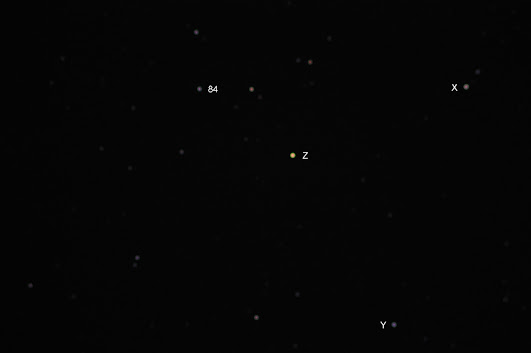On the 7th May I was able take another image of the star field which includes the pulsating variable Z UMa. Like before this was a single 30s exposure at ISO 800 taken (at 21:33 UT) with my 102mm Celestron refractor using my Nikon D90 DSLR at prime focus. Here is the image:-
For comparison, here is the image I took on the 2nd April:-
There are a few things to notice about the differences between these two images; 1) Z and the comparison stars (apart from Y) occupy different positions within frame, 2) the stars in the latest frame are slightly sharper, 3) the background sky in the latest frame is darker. On both occasions the variable star was close to being overhead in the sky when the image was taken (thus minimizing the effects of atmospheric extinction).
I have followed the same procedure as before in my calculation of magnitudes but with a slight modification. I used a circle of diameter 60 pixels rather than 70 pixels to measure the green channel flux of the stars. Then to measure the sky count around a star I used an annulus centred on the star with an inner diameter of 70 pixels and an outer diameter of 120 pixels.
Firstly for Z I found that the mean stellar count was 80.39 over 2828 pixels and the sky was 5.28 over 7452 pixels. This gave a sky subtracted stellar count of 80.39 - 5.28 = 75.11. As said before this all in the green channel. Measurements were done in Photoshop using circular selections and the histogram tool. Note that for the frame taken on the 2nd April, the sky count was 24.20 - so much brighter! This was because the moon was four days from full and well up in the sky.
For star 84 I determined that the stellar count had a mean of 31.82 (again over 2828 pixels) and the sky was 4.74 (over 7452 pixels). This gave a sky subtracted count of 31.82 - 4.74 = 27.08. So that the counts from Z and star 84 can be compared this count needs to be corrected for vignetting. For this I had taken 16 flat frames (ISO 800) with the camera still in the telescope and at the same focus. This was then combined into a master flat frame. Using a 100x100 selection box the count on the master had a mean of 187.39 at the position of Z and 184.32 at the position of star 84. The corrected stellar count for star 84 was therefore (187.39/184.32) x 27.08 = 27.53. Using this comparison star the magnitude of Z is therefore 8.438 - 2.5 log (75.11/27.53) = 7.35 (2 d.p.).
For star X I found the stellar count to have a mean of 48.07 and the sky to be 4.47 giving a sky subtracted count of 48.07 - 4.47 = 43.60. The corrected stellar count was (187.39/177.92) x 43.60 = 45.92. Using this comparison star the magnitude of Z was therefore 7.858 - 2.5 log (75.11/45.92) = 7.32 (2 d.p.).
For star Y the stellar count was 34.11 and the sky count 4.42 giving a sky subtracted count of 29.69. The corrected stellar count was (187.39/178.50) x 29.69 = 31.17. Using this comparison star the magnitude for Z was therefore 8.375 - 2.5 log (75.11/31.17) = 7.42 (2 d.p.).
Hence, using all three estimates I found that the green channel magnitude for Z from my camera was 7.36 +/- 0.05.
This is interesting because on the 2nd April I had found that the magnitude for Z then was 7.38 +/- 0.05 - just 0.02 magnitudes different! This may look odd for a pulsating variable that should have varied more than this over this time until you realise that on the 2nd it was approaching maximum brightness whereas on the 7th (May) it was decreasing again. It just happens to be a coincidence. Note also that on the 2nd the individual estimates were 7.37, 7.34 and 7.44 (for 84, X and Y respectively) and on the 7th these were 7.35, 7.32 and 7.42 - there is exactly 0.02 magnitude difference here too! This is good news as it shows that the variations in the magnitude estimates are not arising from instrumental error but the instrinsic differences of the stars themselves. This in spite of there being differences in how the data was gathered (on different nights with different sky backgrounds, orientations of the stars on the frames and different degrees of focusing - see above).
All text and images © Duncan Hale-Sutton 2023



No comments:
Post a Comment